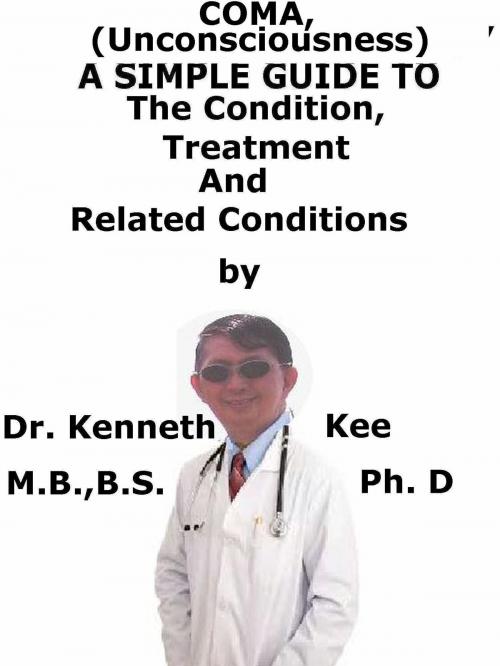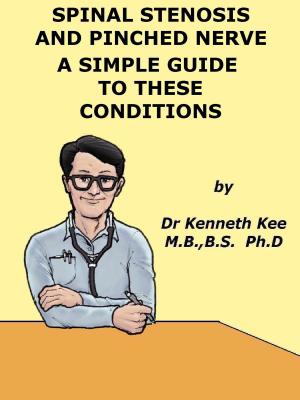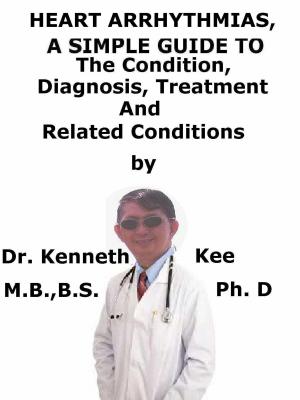Coma, (Unconsciousness) A Simple Guide To The Condition, Treatment And Related Conditions
Nonfiction, Health & Well Being, Health, Ailments & Diseases, Nervous System & the Brain, Medical, Specialties, Internal Medicine, Neurology| Author: | Kenneth Kee | ISBN: | 9781370489862 |
| Publisher: | Kenneth Kee | Publication: | December 12, 2016 |
| Imprint: | Smashwords Edition | Language: | English |
| Author: | Kenneth Kee |
| ISBN: | 9781370489862 |
| Publisher: | Kenneth Kee |
| Publication: | December 12, 2016 |
| Imprint: | Smashwords Edition |
| Language: | English |
A coma is a state of unconsciousness where a person is unresponsive and cannot be woken.
A severe head injury or a condition that affects the brain such as a stroke is two possible causes of a coma.
A person can also be in a coma as a result of alcohol intoxication.
Extreme changes in blood sugar levels in people with diabetes - very low blood glucose levels (hypoglycemia) or very high blood glucose levels (hyperglycemia) - can also cause coma.
You may find the following information useful if you have a friend or a loved one who is in a coma.
Someone who is in a coma has minimal brain activity.
They are alive but cannot move or be woken.
Their potential for recovery will depend on the cause of the coma.
A person in a coma will often be unresponsive to their environment.
They may not be able to hear voices or feel pain.
However, a person in a coma may have some awareness of their surroundings.
Every coma experience is unique.
Occasionally, a person in a coma may open their eyes, grimace or make a noise.
They may not be aware of these movements or have any control over them.
Being in a coma means the person has a low level of consciousness.
Their level of consciousness will depend on how much of their brain is functioning, which may change over time.
For example initially a person may be in a very deep coma where they are unresponsive to pain, before gradually recovering to a lighter coma, where they respond to pain.
They may continue improving and eventually they may become aware of their surroundings and begin to communicate.
The ability to make a clearly conscious response to external instructions indicates that the person is no longer in a coma.
Doctors score a person's level of consciousness using a tool called the Glasgow Coma scale.
The Glasgow Coma Scale assesses three things:
1. Eye opening- a score of one means no eye opening, and four means opens eyes spontaneously
2. Verbal response to a command - a score of one means no response, and five means alert and talking
3. Voluntary movements in response to a command - a score of one means no response, and six means obeys commands
A higher score on the scale suggests that less brain function has been lost.
A score of eight or less is often used to mean that someone is in a relatively deep coma.
Recovery depends on how much of the person’s brain has been affected by the underlying condition or injury.
Generally the longer the person has been in a coma, the poorer the outlook.
People don't usually suddenly 'wake up' from a coma, but tend to come round gradually and regain brain function over time.
When a person comes out of a coma, they may be agitated and confused.
They may need to be sedated for their own safety.
Some people will make a full recovery and be completely unaffected by the coma.
TABLE OF CONTENT
Introduction
Chapter 1 Coma
Chapter 2 Interesting Facts about Coma
Chapter 3 Treatment of Coma
Chapter 4 Hypoglycemic Coma
Chapter 5 Induced Coma
Chapter 6 Subarachnoid Hemorrhage
Chapter 7 Cerebral Aneurysm
Chapter 8 Stroke
Epilogue
A coma is a state of unconsciousness where a person is unresponsive and cannot be woken.
A severe head injury or a condition that affects the brain such as a stroke is two possible causes of a coma.
A person can also be in a coma as a result of alcohol intoxication.
Extreme changes in blood sugar levels in people with diabetes - very low blood glucose levels (hypoglycemia) or very high blood glucose levels (hyperglycemia) - can also cause coma.
You may find the following information useful if you have a friend or a loved one who is in a coma.
Someone who is in a coma has minimal brain activity.
They are alive but cannot move or be woken.
Their potential for recovery will depend on the cause of the coma.
A person in a coma will often be unresponsive to their environment.
They may not be able to hear voices or feel pain.
However, a person in a coma may have some awareness of their surroundings.
Every coma experience is unique.
Occasionally, a person in a coma may open their eyes, grimace or make a noise.
They may not be aware of these movements or have any control over them.
Being in a coma means the person has a low level of consciousness.
Their level of consciousness will depend on how much of their brain is functioning, which may change over time.
For example initially a person may be in a very deep coma where they are unresponsive to pain, before gradually recovering to a lighter coma, where they respond to pain.
They may continue improving and eventually they may become aware of their surroundings and begin to communicate.
The ability to make a clearly conscious response to external instructions indicates that the person is no longer in a coma.
Doctors score a person's level of consciousness using a tool called the Glasgow Coma scale.
The Glasgow Coma Scale assesses three things:
1. Eye opening- a score of one means no eye opening, and four means opens eyes spontaneously
2. Verbal response to a command - a score of one means no response, and five means alert and talking
3. Voluntary movements in response to a command - a score of one means no response, and six means obeys commands
A higher score on the scale suggests that less brain function has been lost.
A score of eight or less is often used to mean that someone is in a relatively deep coma.
Recovery depends on how much of the person’s brain has been affected by the underlying condition or injury.
Generally the longer the person has been in a coma, the poorer the outlook.
People don't usually suddenly 'wake up' from a coma, but tend to come round gradually and regain brain function over time.
When a person comes out of a coma, they may be agitated and confused.
They may need to be sedated for their own safety.
Some people will make a full recovery and be completely unaffected by the coma.
TABLE OF CONTENT
Introduction
Chapter 1 Coma
Chapter 2 Interesting Facts about Coma
Chapter 3 Treatment of Coma
Chapter 4 Hypoglycemic Coma
Chapter 5 Induced Coma
Chapter 6 Subarachnoid Hemorrhage
Chapter 7 Cerebral Aneurysm
Chapter 8 Stroke
Epilogue















